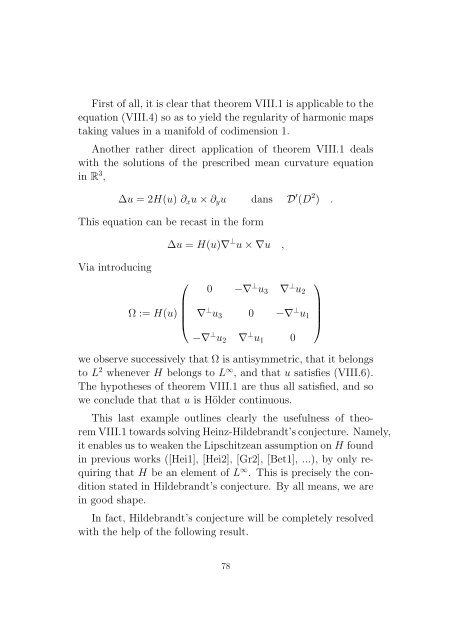Conformally Invariant Variational Problems. - SAM
Conformally Invariant Variational Problems. - SAM
Conformally Invariant Variational Problems. - SAM
You also want an ePaper? Increase the reach of your titles
YUMPU automatically turns print PDFs into web optimized ePapers that Google loves.
First of all, it is clear that theorem VIII.1 is applicable to the<br />
equation (VIII.4) so as to yield the regularity of harmonic maps<br />
taking values in a manifold of codimension 1.<br />
Another rather direct application of theorem VIII.1 deals<br />
with the solutions of the prescribed mean curvature equation<br />
in R 3 ,<br />
∆u = 2H(u) ∂ x u×∂ y u dans D ′ (D 2 ) .<br />
This equation can be recast in the form<br />
∆u = H(u)∇ ⊥ u×∇u ,<br />
Via introducing<br />
⎛<br />
Ω := H(u) ⎜<br />
⎝<br />
0 −∇ ⊥ u 3 ∇ ⊥ u 2<br />
∇ ⊥ u 3 0 −∇ ⊥ u 1<br />
−∇ ⊥ u 2 ∇ ⊥ u 1 0<br />
⎞<br />
⎟<br />
⎠<br />
we observe successively that Ω is antisymmetric, that it belongs<br />
to L 2 whenever H belongs to L ∞ , and that u satisfies (VIII.6).<br />
The hypotheses of theorem VIII.1 are thus all satisfied, and so<br />
we conclude that that u is Hölder continuous.<br />
This last example outlines clearly the usefulness of theoremVIII.1towardssolvingHeinz-Hildebrandt’sconjecture.<br />
Namely,<br />
it enablesus to weakenthe Lipschitzeanassumptionon H found<br />
in previous works ([Hei1], [Hei2], [Gr2], [Bet1], ...), by only requiring<br />
that H be an element of L ∞ . This is precisely the condition<br />
stated in Hildebrandt’s conjecture. By all means, we are<br />
in good shape.<br />
In fact, Hildebrandt’s conjecture will be completely resolved<br />
with the help of the following result.<br />
78
















